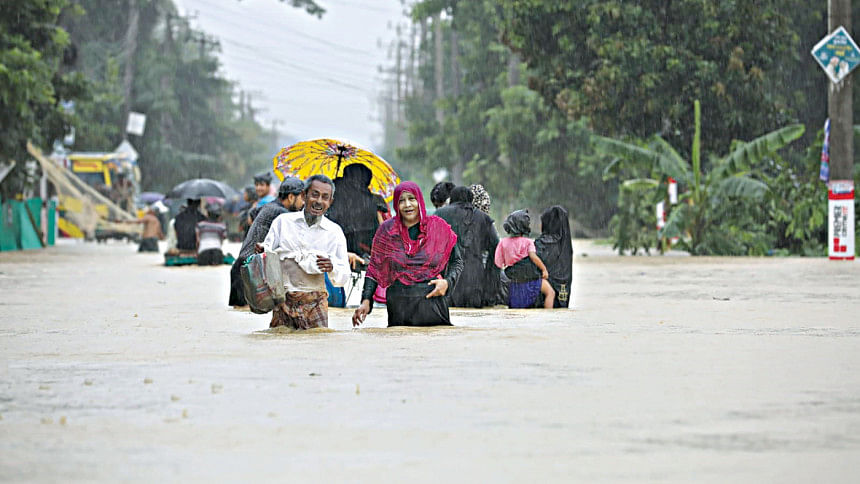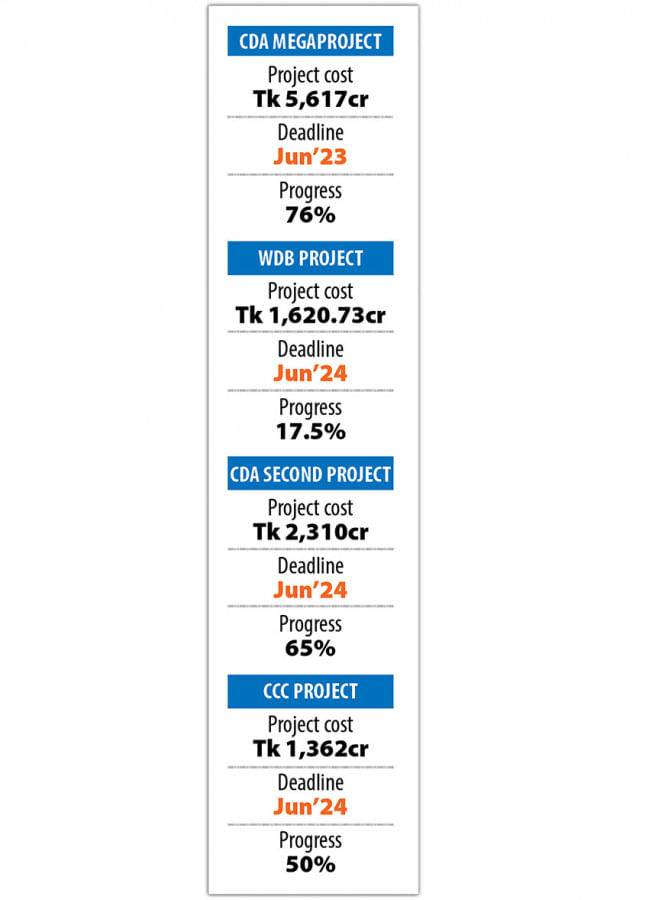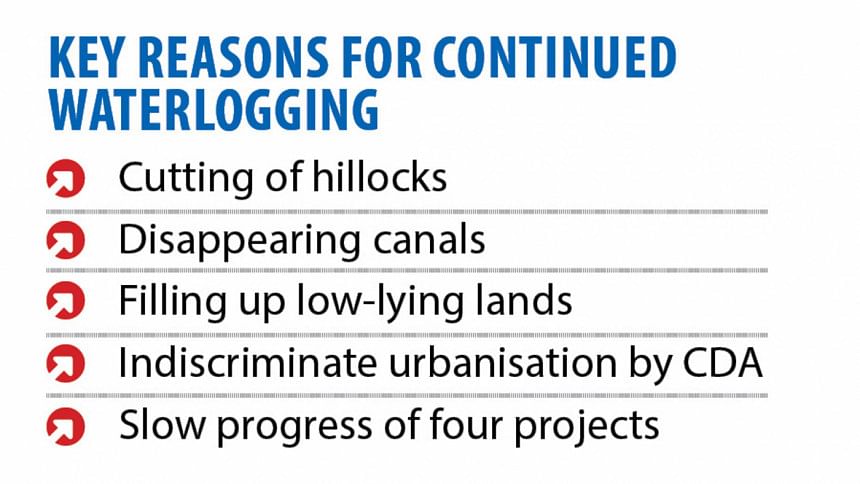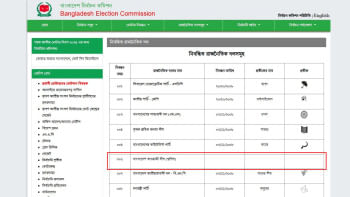Chattogram city condemned to waterlogging

It is often said that if we hurt Mother Nature, we end up hurting ourselves. This saying could not be truer than in the case of Chattogram, the commercial capital of Bangladesh, during monsoons, when it goes under water for the most part.
Once dotted with hills, hillocks and canals, Bangladesh's second-largest city is now full of concrete buildings and has become the poster child of indiscriminate and ruthless urbanisation.
The result has been an alarming environmental degradation that makes the lives of its 5.2 million residents virtually unbearable during the monsoon every year.

"A city should have 25 to 30 percent green space so that the earth can soak the rainwater, but as much as 85 percent of Chattogram city is filled with concrete establishments or bitumen," said Muhammad Rashidul Hasan, a professor at the department of urban and regional planning at the Chittagong University of Engineering and Technology (Cuet).
As the green space has shrunk to less than 15 percent, there is very little place for the retention of rainwater.
Hill cutting is a major reason for waterlogging, he said.
When it rains, soil and stones from the hills flow down and clog up the drains and canals and obstruct the flow of water.
Then in the past 50 years, 70 percent of the city's water bodies were filled up. Apart from ponds, many canals have disappeared from the city due to illegal occupation.
The city once had 72 canals, but Chattogram Wasa's existing drainage master plan shows 56 canals, according to Hasan.

Even those are clogged up by silt, polythene and plastic wastes.
This raises the question: where will the rainwater go?
Hasan went on to blame the predatory role of the Chattogram Development Authority (CDA) for the ever-shrinking green space and water bodies.
It has approved building construction in vast swathes of low-lying areas that used to play a key role in retaining rainwater, according to Hasan.
The CDA itself has gone for land development by filling up low-lying areas in Kuaish, Oxygen, Chandgaon and Bakalia.
"The Kalpolok Residential Area and Ananya Residential Area are two glaring examples of this," Hasan added.
In a flagrant violation of the Natural Water Reservoir Conservation Act 2000, the CDA in 2012 decided to approve the filling up of waterbodies between 30 katha and 15 katha by taking permission from the Department of Environment. And those below 15 katha can be filled up taking permission from the CDA.
No waterbody can be filled up as per the Natural Water Reservoir Conservation Act 2000, said Shahinul Islam Khan, a former chief town planner of the CDA.
The act stipulates that the waterbodies be identified through a gazette notification, and it was the duty of the CDA to do so.
The CDA board did the opposite by taking advantage of a grey area in the act, Khanadded.
"Instead of playing the role of a protector of low-lying areas, the CDA is acting like a predator. They are more interested in taking up mega development projects than taking action against illegal occupants," Hasan said.
Contacted, CDA Chairman Jahirul Alam said the decision would be revised at the soonest and the water bodies would not be allowed to be filled up.
Regarding the development projects, he said: "The CDA takes up development projects for the sake of people, not for business. Because of these projects, people can own plots."
Meanwhile, the government has taken up four projects involving about Tk 11,000 crore to address the waterlogging -- but to little effect.
All four projects have either missed the deadline or are running well behind schedule.
Since 2017, the CDA has been implementing a mega project worth Tk 5,617 crore that promised to alleviate waterlogging in the port city by leaps and bounds by June 2020.
The project entails extraction of mud from 36 canals, construction of 85.68 kilometres of roads on the banks of important canals, 10.77 km of new drains, expansion of 15.5 km of side drains, 200 cross drain culverts, building of 48 guarder bridges, six culverts, five tidal regulators and 42 silt traps.
The project, which is being implemented by the Bangladesh Army, failed to meet the deadline and was given a three-year extension. But the June 2023 deadline was also missed, with the project's progress now standing at 76 percent.
"It is a faulty project from design to phase-wise construction management," said Subhash Chandro Barua, a town planner.
For instance, the CDA mega project seeks to address 36 out of 56 canals when it should have included all the 56 canals, said Cuet professor Hasan.
Since not all canals are being cleared up, the city's waterlogging problem would not go away fully, he said.
The CDA submitted the project hurriedly without conducting an environmental impact study, according to Hasan.
Although the overall progress of the CDA mega project is 76 percent, it is not result-oriented, as people are not getting its benefit, said Delwar Majumder, former president of the Institute of Engineers Bangladesh (IEB), Chattogram.
The retaining walls built on either side of the canals under the project are creating obstacles to receding rainwater as those have been made two to three feet high from the road.
Besides, the sluice gates on the mouth of canals are not functional while the pump houses cannot pump rainwater due to a lack of engines, Majumdar said.
The non-inclusion of the secondary and tertiary drains in the project was a major fault, according to Barua. "If the secondary and tertiary drains are not cleaned up, how would water flow to the primary drains and canals?"
This should have been addressed at the start of the project, Barua said, while questioning the veracity of the CDA's claim that 76 percent of the project work has been completed.
"If that was the case, there would have been a lot of improvement in the waterlogging problem."
De-siltation of canals should have been the priority of the project. A total of 9.50 lakh cubic metres of mud are supposed to be extracted from 36 canals.
"But we don't know exactly how much soil has been extracted from the canals in six years," Barua added.
Rezaul Karim Chowdhury, mayor of Chattogram City Corporation (CCC), said that the CDA has extracted just one-third of the soil so far.
"As most of the soil has not been extracted from canals, those cannot contain rainwater," he added.
Shah Ali, a lieutenant colonel of the Bangladesh Army who is serving as the project director, refuted most of the allegations, saying that residents in many areas were getting the benefit from the mega project.
"A vast area in Agrabad and Halishahar used to go under water during high tide earlier but now these areas do not go under tidal water," he said.
Previously, the Prabartak intersection used to go under water whenever it rained but the intersection has been freed from waterlogging in the past two years.
He also asserted that rainwater now recedes within an hour in the city instead of several hours before.
Ali also said the non-inclusion of secondary and tertiary canals and drains in the project was not a major weakness.
"Our project is not aimed at addressing waterlogging of the whole city. Like our project, some other projects have been undergoing in the city in a bid to ease the waterlogging problem," he said, citing the exclusion of 20 canals from excavation and the secondary and tertiary drains.
Asked about the allegation of not extracting enough soil from the canals, Ali said: "We were supposed to extract 9.5 lakh metres of soil from 36 canals but we have extracted more than that. We have even extracted soil and garbage from the drains and canals. This was not under our jurisdiction."
The soil and garbage from the canals and drains are extracted twice a year but they get filled up with silt every monsoon and with plastic and polythene garbage throughout the year, according to Ali.
Works in 16 of the canals have already been completed, while the work on some canals including two major ones -- Chaktai Khal and Hizra Khal -- has made little headway due to complications in land acquisition.
"We cannot move our excavators as the banks of the canals are very narrow."
A 5,850-metre retaining wall was supposed to be built along the 5.8 km Chaktaki Khal.
"But so far we could build retaining walls in 2,900-metre areas as the CDA is yet to hand over the land to us. If we start excavating the canals without building retaining walls, all the buildings and structures on the banks would collapse."
He said that they had started the work before the land acquisition with the assurance from the CDA that they would get the land on time.
"But in five years we are yet to get the whole acquired land. It is the failure of CDA," Ali added.
CDA passed the blame on bureaucratic delays.
When the development project plan was approved in 2017, the government's compensation rate for land acquisition was 1.5 times higher than the land's usual price, said Hasan Bin Shams, chief engineer of the CDA.
However, the government in 2018 increased the compensation rate to three times the land's value.
"For this reason, we have sent a revised DPP to the government but it is yet to be approved," he added.
The CDA has been implementing another project worth Tk 2,310 crore since June 2017. It is scheduled to be completed by June 2024. Only 65 percent of the work has been done so far.
Apart from constructing a dam on the banks of the Karnaphuli river and Chaktai and Razakhali canals, 12 sluice gates and pump houses would be installed to regulate tidal water, according to Shams.
So far, 11 sluice gates have been installed and not the pump houses, he said.
Since 2014, CCC has been implementing a project to dig a canal from Bahaddarhat Baroipara to the Karnaphuli.
The Tk 1,362 crore project was supposed to have been wrapped up by June 2017, but its deadline has been extended to June 2024. The overall progress of the project is 50 percent.
Forhadul Alam, its project director, blamed the delays on land acquisition, which is yet to be completed.
CCC has got 21 acres of land from Chattogram District Administration out of the 25 acres of land promised, he said, adding that the canal is being constructed on the land.
The Water Development Board (WDB) has been implementing a project worth Tk 1,620.73 crore since 2019 on Chattogram's flood control, waterlogging alleviation and drainage development.
As of July, the project, which is scheduled to be completed by June 2024, has seen only 17.5 percent progress.
The project was not directly linked to addressing waterlogging in the city, said Showkat Ibne Shahid, executive engineer of WDB, Chattogram.
"We do not have a mandate for work in the city but we took up the project at that time upon request from the city corporation."
The project work started in August 2021 and is scheduled to be completed by June 2024.
"But I think the project deadline would have to be extended to June 2027," he added.
All the projects will have to be brought under strict monitoring and accountability, said Barua, the town planner, adding that the projects should be managed by an expert institutional system.
The government will have to form an umbrella organisation for coordination of the master plan, said the former IEB, Chattogram president Majumder, adding that all disappeared canals will have to be reclaimed.
The four canals that the CDA drainage master plan 1995 recommended for construction must be done, said CUET professor Hasan.
Besides, coordination between the project implementing authorities -- CDA, CCC and WDB -- will have to be increased and the three organisations will have to work in tandem.
More town planners must be recruited.
"The city corporation does not have any town planner in its ranks, while the CDA has one or two," Hasan added.
This, perhaps, sums up the reason the once verdant city has become a concrete jungle and a vessel for rainwater.

 For all latest news, follow The Daily Star's Google News channel.
For all latest news, follow The Daily Star's Google News channel. 








Comments